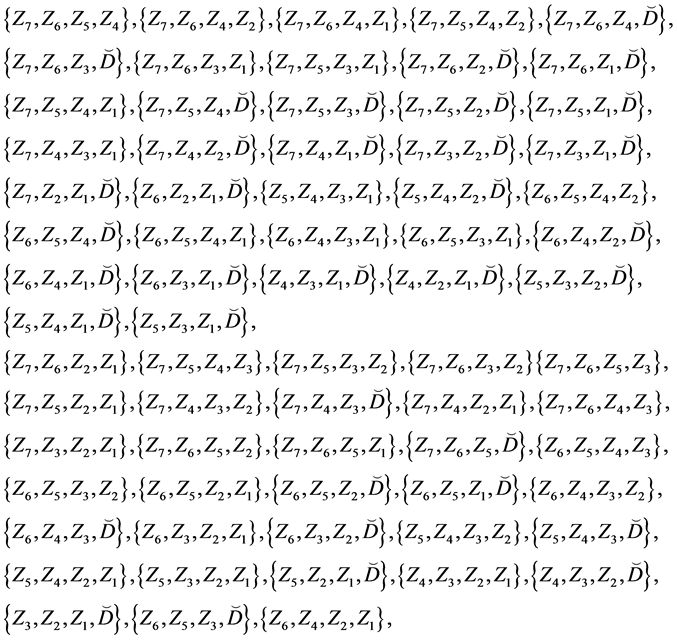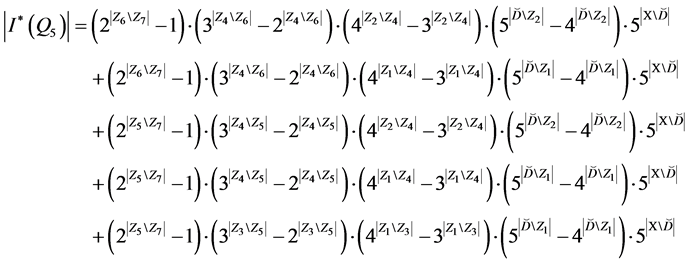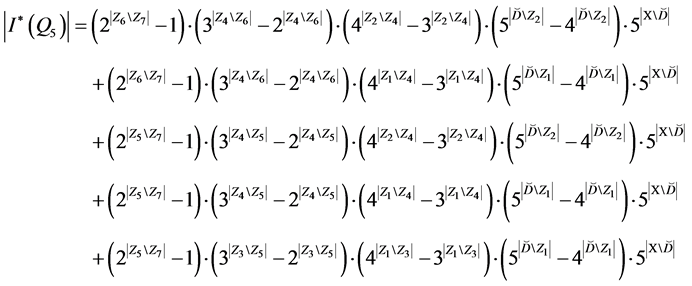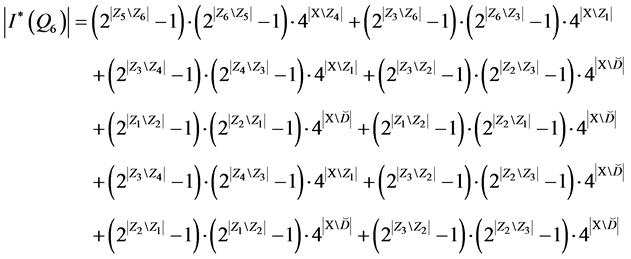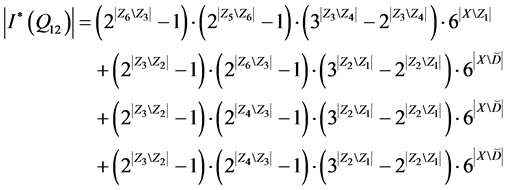Applied Mathematics
Vol.07 No.03(2016), Article ID:63809,26 pages
10.4236/am.2016.73019
Idempotent Elements of the Semigroups  Defined by Semilattices of the Class
Defined by Semilattices of the Class  When
When 
Giuli Tavdgiridze, Yasha Diasamidze, Omari Givradze
Faculty of Physics, Mathematics and Computer Sciences, Department of Mathematics, Shota Rustaveli Batumi State University, Batumi, Georgia

Copyright © 2016 by authors and Scientific Research Publishing Inc.
This work is licensed under the Creative Commons Attribution International License (CC BY).



Received 21 June 2015; accepted 22 February 2016; published 25 February 2016
ABSTRACT
In the paper, complete semigroup binary relation is defined by semilattices of the class . We give a full description of idempotent elements of given semigroup. For the case where X is a finite set and
. We give a full description of idempotent elements of given semigroup. For the case where X is a finite set and , we derive formulas by calculating the numbers of idempotent elements of the respective semigroup.
, we derive formulas by calculating the numbers of idempotent elements of the respective semigroup.
Keywords:
Semilattice, Semigroup, Binary Relation, Idempotent Element

1. Introduction
Let X be an arbitrary nonempty set, D be a X-semilattice of unions, i.e. a nonempty set of subsets of the set X that is closed with respect to the set-theoretic operations of unification of elements from D, f be an arbitrary mapping from X into D. To each such a mapping f there corresponds a binary relation  on the set X that satisfies the condition
on the set X that satisfies the condition . The set of all such
. The set of all such 
 is denoted by
is denoted by . It is
. It is
easy to prove that  is a semigroup with respect to the operation of multiplication of binary relations,
is a semigroup with respect to the operation of multiplication of binary relations,
which is called a complete semigroup of binary relations defined by a X-semilattice of unions D (see 2.1 p. 34 of [1] ).
By  we denote an empty binary relation or empty subset of the set X. The condition
we denote an empty binary relation or empty subset of the set X. The condition  will be written in the form
will be written in the form . Further let
. Further let ,
, 




By symbol 

Definition 1.1. Let





Definition 1.2. We say that a complete X-semilattice of unions D is an XI-semilattice of unions if it satisfies the following two conditions:
a) 

b) 
Definition 1.3. Let D be an arbitrary complete X-semilattice of unions,
then it is obvious that any binary relation 



Note that for a quasinormal representation of a binary relation


a)


b)
Definition 1.4. We say that a nonempty element T is a nonlimiting element of the set 


Definition 1.5. Let us assume that by the symbol 

Further, let 






Further, if Q ia a XI-subsemilattice of unions, then by the symbol 


Theorem 1.1. A binary relation 


Theorem 1.2. Let D be a complete X-semilattice of unions. The semigroup 
Theorem 1.3. Let X be a finite set and 



representation 
a) 
b) 

c) 

Theorem 1.4. Let D, 




a) if 

1) 




2)
3) The equality 
b) if
1) 




2)
3) The equality 
Lemma 1.1. Let 







Lemma 1.2. Let




X in the set 

Lemma 1.3. Let D by a complete X-semilattice of unions. If a binary relation 



unit of that semigroup (see [2] , Lemma 12.1.2 or [3] , lemma 1.1.2).
Theorem 1.5. Let 








In the sequel these equalities will be called formal.
It is proved that if the elements of the semilattice D are represented in the form (1.1), then among the parameters 




The number the basis sources we denote by symbol
It is proved that under the mapping 

Theorem 1.6. Let X be a finite set; 



where 
we give complete classification all XI-subsemilattices of the semilatticeopf the class
we derive formulas by calculation the numbers of the semilattices of the given class.
2. Results
In this subsection it is assumed that 

By the symbol 


The semilattice satisfying the conditions (2.1) is shown in Figure 1.
It is further assumed that 

where 


Figure 1. Diagram of D.
Lemma 2.1. Let



Proof. In this case we have:



where

The Lemma is proved.
Example 2.1. Let 

The number obtained show that if, for instance

Let us define all subsemilattice of the semilattice D.
Lemma 2.2. Let
1)
(see diagram 1 of the Figure 2);
2)
(see diagram 2 of the Figure 2);
3)
(see diagram 3 of the Figure 2);
4)
(see diagram 4 of the Figure 2);
5)
(see diagram 5 of the Figure 2);
6)
(see diagram 6 of the Figure 2);
7)
(see diagram 7 of the Figure 2);
8)
(see diagram 8 of the Figure 2);
9)
(see diagram 9 of the Figure 2);
10)
(see diagram 10 of the Figure 2);
11)
(see diagram 11 of the Figure 2);
12)
(see diagram 12 of the Figure 2);
13)
(see diagram 13 of the Figure 2);
14)
(see diagram 14 of the Figure 2);
15)
(see diagram 15 of the Figure 2);
16)
(see diagram 16 of the Figure 2);
17)
(see diagram 17 of the Figure 2);
18)
(see diagram 18 of the Figure 2);
19)
(see diagram 19 of the Figure 2);
20)
(see diagram 20 of the Figure 2);
21)
(see diagram 21 of the Figure 2);
22)
(see diagram 22 of the Figure 2);
23)
Figure 2. All diagrams of subsemilattices of the semilattice D.
(see diagram 23 of the Figure 2);
24)
(see diagram 24 of the Figure 2);
25)
(see diagram 25 of the Figure 2);
26)
(see diagram 26 of the Figure 2);
27)
(see diagram 27 of the Figure 2);
28)
(see diagram 28 of the Figure 2);
29)
(see diagram 29 of the Figure 2);
30) 
Proof. It is easy to see that, the sets 
The number subsets of the semilattise D, which contain two element is equal to
It is easy to see that, last five sats are not subsemilattices of the semilattice D.
The number subsets of the semilattise D, which contain tree element is equal to
It is easy to see that, last twenty sats are not subsemilattices of the semilattice D.
The number subsets of the semilattise D, which contain four element is equal to
is easy to see that, last 33 sats are not subsemilattices of the semilattice D.
The number subsets of the semilattise D, which contain five element is equal to
is easy to see that, last 29 sats are not subsemilattices of the semilattice D.
The number subsets of the semilattise D, which contain six element is equal to
is easy to see that, last 13 sats are not subsemilattices of the semilattice D.
The number subsets of the semilattise D, which contain seven element is equal to
is easy to see that, last 3 sats are not subsemilattices of the semilattice D.
From the proven lemma it follows that diagrams shown in Figure 2, exhaust all diagrams of subsemilattices of the semilattice D.
Lemma 2.3. Let 

Proof: Remark, that the all subsemilattices of semilattice D which has diagrams of form 17 - 30 are never XI-semilattices. For example we consider the semilatticesuchis defined by the diagram of the form 30 of the Figure 2.
Let 



ping of the semilattice 


Here, the elements 




We have 





Lemma is proved.
Lemma 2.4. Let 

1)
(see diagram 1 of the Figure 4);
2)
(see diagram 2 of the Figure 4);
3)
(see diagram 3 of the Figure 4);
Figure 3. Diagram of
Figure 4. All diagrams XI-subsemilattices of thesemilattice D.
4)
(see diagram 4 of the Figure 4);
5)
(see diagram 5 of the Figure 4);
6)
(see diagram 6 of the Figure 4);
7)
(see diagram 7 of the Figure 4);
8)
(see diagram 8 of the Figure 4);
9)
(see diagram 9 of the Figure 4);
10)
(see diagram 10 of the Figure 4);
11)
(see diagram 11 of the Figure 4);
12)
(see diagram 12 of the Figure 4);
13)
(see diagram 13 of the Figure 4);
14)
(see diagram 14 of the Figure 4);
15)
(see diagram 15 of the Figure 4);
16) 
Proof: The statements 1), 2), 3), 4), 5) immediately follows from the Theorems 11.6.1 in [2] , 11.6.1 in [3] , the statements 6), 7), 8), 9), 10), 11) immediately follows from the Theorems 11.6.3in [2] , 11.6.3 in [3] ; the statement 12) immediately follows from the Theorems 11.7.2 in [2] ; the statement 13) immediately follows from the Theorema 2.1 in [4] , the statement 14) immediately follows from the lemma 2.1. in [5] , the statements 15) immediately follows from the Theorems 13.11.1 in [2] and the statement 16) immediately follows from the theorem 2.1. in [6] .
We denote the following semitattices 
1)
2) 


3) 


4) 


5) 

6) 





7) 




8) 

9) 




10) 





11) 

12) 







13) 







14) 

15)
16)
Theorem 2.1. Let





1)

2)





3)







4)









5)










6)










7)












8)











9)













10)











11)









12)














13)
















14)









15)









16)










Proof. The statements 1), 2), 3), 4) and 5) immediately follows from the Corollary 13.1.1 in [2] , 13.1.1 in [3] , the statements 6) - 11) immediately follows from the Corollary 13.3.1 in [2] , 13.3.1 in [3] ; the statement 12) immediately follows from the Theorems 13.7.2 in [2] ; the statement 13) immediately follows from the corollary 2.1 in [4] , the statement 14) immediately follows from the lemma 2.1. in [5] , the statements 15) immediately follows from the Theorems 13.11.1 in [2] and the statement 16) immediately follows from the theorem 2.1. in [6] .
Lemma 2.6. If X be a finite set, then the following equalities are true:
a)
b)
c)
d)
e)
f)
g)
h)
i)
j)
k)
l)
m)
n)
o)
p)
Proof. The statements 1), 2), 3), 4), 5) immediately follows from the Corollary 13.1.5 in [2] ,
13.1.5 in [3] , the statements 6)-12) immediately follows from the Corollary 13.3.3 in [2] , 13.3.3 in [3] , the statement 13 immediately follows corollary 1.5 in [4] and corollary 6.3.6 in [3] , the statement 14 immediately follows from corollary 2.1 in [5] and corollary 6.3.6 in [3] , the statement 15) immediately follows from the Corollary 13.11.1 in [2] and the statement 16 immediately follows from the Corollary 2.1 in [6] .
Theorem is proved.
Lemma 2.7. Let 



Proof. By definition of the given semilattice D we have

If the following equalities are hold

then
(see Theorem 1.4). Of this equality we have:
(see statement a) of the Lemma 2.6).
Lemma 2.8. Let 


Proof. By definitionof the given semilattice D we have
if
Then
(see Theorem 1.4). Of this equality we have:
(see statement b) of the Lemma 2.6).
Lemma is proved.
Lemma 2.9. Let 


Proof. By definition of the given semilattice D we have
If
Then
(see Theorem 1.4). Of this equality we have:
(see statement c) of the Lemma 2.6).
Lemma is proved.
Lemma 2.10. Let 


Proof. By definition of the given semilattice D we have
If
Then
(see Theorem 1.4). Of this equality we have:
(see statement d) of the Lemma 2.6).
Lemma is proved.
Lemma 2.11. Let 


Proof. By definition of the given semilattice D we have
If
Then
(see Theorem 1.4). Of this equality we have:
(see statement e) of the Lemma 2.6).
Lemma is proved.
Lemma 2.12. Let 


Proof. By definition of the given semilattice D we have
(see Theorem 1.4). Of this equality we have:
(see statement f) of the Lemma 2.6).
Lemma is proved.
Lemma 2.13. Let 


Proof. By definition of the given semilattice D we have
If
(see Theorem 1.4). Of this equality we have:
(see statement g) of the Lemma 2.6).
Lemma is proved.
Lemma 2.14. Let 


Proof. By definition of the given semilattice D we have
If
(see Theorem 1.4). Of this equality we have:
(see statement h) of the Lemma 2.6).
Lemma is proved.
Lemma 2.15. Let 


Proof. By definition of the given semilattice D we have
If the following equality is hold 
(see Theorem 1.4). Of this equality we have:
(see statement i) of the Lemma 2.6).
Lemma is proved.
Lemma 2.16. Let 


Proof. By definition of the given semilattice D we have
If
(see Theorem 1.4). Of this equality we have:
(see statement j) of the Lemma 2.6).
Lemma is proved.
Lemma 2.17. Let 


Proof. By definition of the given semilattice D we have
If
(see Theorem 1.4). Of this equality we have:
(see statement k) of the Lemma 2.6).
Lemma is proved.
Lemma 2.18. Let 


Proof. By definition of the given semilattice D we have
(see Theorem 1.4). Of this equality we have:
(see statement l) of the Lemma 2.6).
Lemma is proved.
Lemma 2.19. Let 


Proof. By definition of the given semilattice D we have 

(see Theorem 1.4). Of this equality we have:
(see statement m) of the Lemma 2.6).
Lemma is proved.
Lemma 2.20. Let 


Proof. Bydefinitionof the given semilattice D we have 

(see Theorem 1.4). Of this equality we have:
(see statement n) of the Lemma 2.6).
Lemma is proved.
Lemma 2.21. Let 


Proof. By definition of the given semilattice D we have 

(see Theorem 1.4). Of this equality we have:
(see statement o) of the Lemma 2.6).
Lemma is proved.
Lemma 2.22. Let 


Proof. By definition of the given semilattice D we have

(see Theorem 1.4). Of this equality we have:
(see statement p) of the Lemma 2.6).
Lemma is proved
Theorem 2.2. Let 


Proof. This Theorem immediately follows from the Theorem 2.1.
Theorem is proved.
Example 2.1. Let

Then







Then we have that following equality are hold:

















Cite this paper
Giuli Tavdgiridze,Yasha Diasamidze,Omari Givradze, (2016) Idempotent Elements of the Semigroups Bx(D) Defined by Semilattices of the Class ∑3(x,8) When Z7‡ Ø. Applied Mathematics,07,193-218. doi: 10.4236/am.2016.73019
References
- 1. Clifford, A.H. and Preston, G.B. (1961) The Algebraic Theory of Semigroups. (Russian) American Mathematical Society, Providence.
- 2. Diasamidze, Ya. and Makharadze, Sh. (2013) Complete Semigroups of Binary Relations. Kriter, Turkey.
- 3. Diasamidze, Ya. and Makharadze, Sh. (2010) Complete Semigroups of Binary Relations. Sputnik+, Moscow (Russian).
- 4. Diasamidze, Ya. and Tavdgiridze, G. (2015) Some Regular Elements, Idempotents and Right Units of Semigroup Defined by X-Semilattices Which Is Union of a Chain and Two Rhombus. General Mathematics Notes, 26, 84-101.
- 5. Diasamidze, Ya. and Tavdgiridze, G. (2015) Some Regular Elements, Idempotents and Right Units of Semigroup Defined by X-Semilattices Which Is Union Two Rhombus and of a Chain. International Journal of Scientific Engineering and Applied Science (IJSEAS), 1, 548-556.
- 6. Diasamidze, Ya. and Tavdgiridze, G. (2015) Regular Elements and Right Units of Semigroup Define Semilattice D for Which Applied Mathematics, 6, 373-381.
http://dx.doi.org/10.4236/am.2015.62035











































